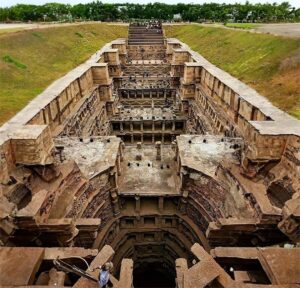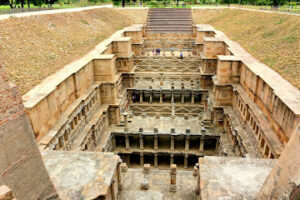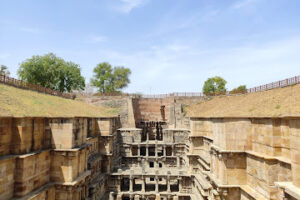1. Introduction to Rani-ki-Vav
Located in Patan, Gujarat, India, Rani-ki-Vav, or “The Queen’s Stepwell,” is a masterpiece of architecture and craftsmanship from ancient India. Built in the 11th century under the Solanki dynasty, this stepwell has been recognized as a UNESCO World Heritage Site, drawing the attention of thousands of visitors and cultural researchers every year. With its intricate carvings and unique stepped structure, it serves as not only a water storage facility but also as a powerful cultural, historical, and spiritual symbol.

2. History and Cultural Significance
Rani-ki-Vav was commissioned by Queen Udayamati in memory of her husband, King Bhima I. This stepwell is more than just a water storage structure; it symbolizes love and devotion. With each descending step, Rani-ki-Vav guides visitors deeper into a realm of culture and religious beliefs, featuring carvings that depict Hindu deities like Vishnu, Brahma, and Shiva. Over the centuries, it has served as a pilgrimage site where devotees come to pray and find peace.
3. Marvelous Design and Architecture
3.1. Unique Stepwell Structure
Rani-ki-Vav is designed as an inverted temple, meaning it appears as though the temple itself is carved into the ground when viewed from above. With a depth of over 30 meters and more than 500 sculptures, the structure consists of seven terraces that descend toward the water. Each level feels like an entry into a spiritual journey, where carvings tell sacred tales from ancient India.
3.2. Intricate and Mystical Carvings
The most captivating feature of Rani-ki-Vav is its detailed reliefs and carvings, depicting deities, people, and mythical creatures in astonishing detail. These works are not just a reflection of artistic talent but also a testament to the artisans’ deep cultural, religious, and philosophical understanding. The carvings of Lord Vishnu in his various incarnations, such as Narasimha (lion) and Varaha (boar), are considered highlights of this structure.

4. Functionality and Spirituality
4.1. Water Storage System
Originally, the stepwell was built to supply and store water for local residents, helping them through dry seasons. Water from the Saraswati River fed into the stepwell, ensuring a stable water source. Apart from its hydraulic function, the stepwell stands as a prime example of ancient Indian water management and construction skills.
4.2. A Sacred Space
Rani-ki-Vav is not just a stepwell but also a sacred space where people come to meditate and pray. The descent into the depths of the well is symbolic of purification, a journey from the mundane world to a spiritual dimension. The structure and carvings emphasize the important role that public spaces like stepwells played in the spiritual and cultural lives of ancient Indians.

5. Rani-ki-Vav: A UNESCO World Heritage Site
In 2014, UNESCO designated Rani-ki-Vav as a World Heritage Site, recognizing its contribution to art and architecture. This designation highlights not only its artistic value but also the role of public spaces in preserving culture and history. Today, the stepwell is a famous destination for those wishing to explore the architecture, history, and traditions of ancient India.
6. Discovering Rani-ki-Vav: Highlights Not to Miss
When visiting Rani-ki-Vav, travelers can marvel at its unique architecture and admire the intricate carvings. As they descend each step, they will experience the sacred ambiance, a sense of peace, and a connection to ancient traditions.
7. Conclusion
Rani-ki-Vav is a powerful testament to the creativity and cultural spirit of ancient Indians. More than an architectural feat, it is a convergence of art, history, and spirituality. As a World Heritage Site, Rani-ki-Vav continues to attract and inspire future generations, helping them appreciate the legacy and culture passed down through the ages.
